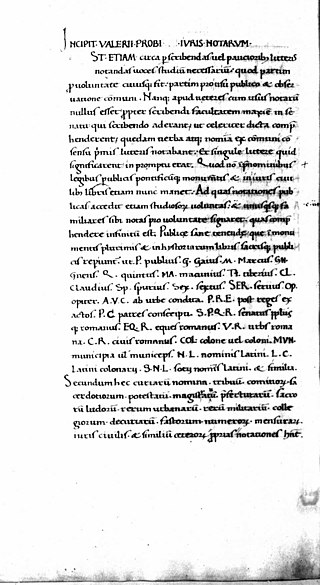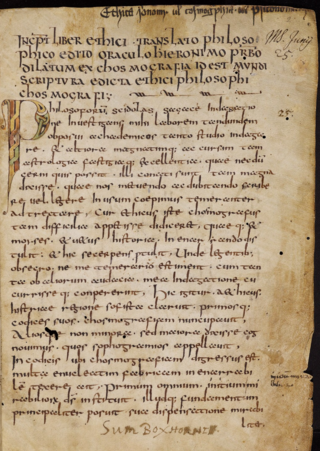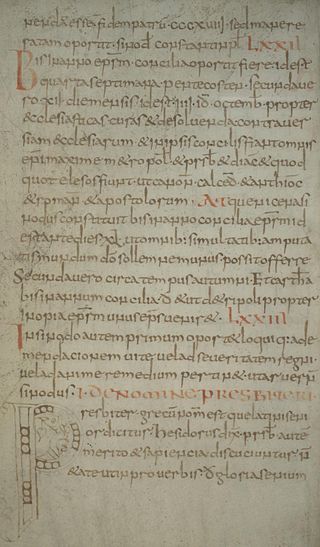Related Research Articles

Priscianus Caesariensis, commonly known as Priscian, was a Latin grammarian and the author of the Institutes of Grammar, which was the standard textbook for the study of Latin during the Middle Ages. It also provided the raw material for the field of speculative grammar.

Servius, distinguished as Servius the Grammarian, was a late fourth-century and early fifth-century grammarian. He earned a contemporary reputation as the most learned man of his generation in Italy; he authored a set of commentaries on the works of Virgil. These works, In Tria Virgilii Opera Expositio, Commentarii in Virgilium, Commentarii in Vergilii Opera, or Vergilii Carmina Commentarii, constituted the first incunable to be printed at Florence, by Bernardo Cennini, in 1471.

Angelo Mai was an Italian Cardinal and philologist. He won a European reputation for publishing for the first time a series of previously unknown ancient texts. These he was able to discover and publish, first while in charge of the Ambrosian Library in Milan and then in the same role at the Vatican Library. The texts were often in parchment manuscripts that had been washed off and reused; he was able to read the lower text using chemicals. In particular he was able to locate a substantial portion of the much sought-after De republica of Cicero and the complete works of Virgilius Maro Grammaticus.

Marcus Valerius Probus, also known as M. Valerius Probus Berytius or Probus the Berytian, was a Roman grammarian and critic, who flourished during Nero's reign.
Hiberno-Latin, also called Hisperic Latin, was a learned style of literary Latin first used and subsequently spread by Irish monks during the period from the sixth century to the tenth century.

Lucius Junius Moderatus Columella was a prominent Roman writer on agriculture in the Roman Empire.
Censorinus was a Roman grammarian and miscellaneous writer.

Aethicus Ister was the protagonist of the 7th/8th-century Cosmographia, purportedly written by a man of church Hieronymus, who purportedly censors an even older work for producing the book as its censored version. It is a forgery from the Middle Ages.

Tatwine was the tenth Archbishop of Canterbury from 731 to 734. Prior to becoming archbishop, he was a monk and abbot of a Benedictine monastery. Besides his ecclesiastical career, Tatwine was a writer, and riddles he composed survive. Another work he composed was on the grammar of the Latin language, which was aimed at advanced students of that language. He was subsequently considered a saint.
Publius Valerius Cato was a grammarian and poet of the Roman Republic. He was a leader of the Neoteric movement, whose followers rejected national epic and drama in favor of the artificial mythological epics and elegies of the Alexandrian school, preferring Euphorion of Chalcis to Ennius. They regarded knowledge of Greek literature and myths, and strict adherence to metrical rules, as indispensable to the poet. The great influence of Cato is attested by the lines: Cato grammaticus, Latina Siren, Qui solus legit ac facit poetas.
The First Grammatical Treatise is a 12th-century work on the phonology of the Old Norse or Old Icelandic language. It was given this name because it is the first of four grammatical works bound in the Icelandic manuscript Codex Wormianus. The anonymous author is today often referred to as the "First Grammarian".

Johannes de Garlandia or John of Garland was a medieval grammarian and university teacher. His dates of birth and death are unknown, but he probably lived from about 1190 to about 1270.

The Collectio canonum Hibernensis is a systematic Latin collection of Continental canon law, scriptural and patristic excerpts, and Irish synodal and penitential decrees. Hib is thought to have been compiled by two Irish scholars working in the late 7th or 8th century, Cú Chuimne of Iona and Ruben of Dairinis.
Sedulius Scotus or Scottus was an Irish monk, teacher, Latin grammarian, and scriptural commentator who lived in the 9th century. During the reign of the Emperor Lothair (840–855), he was one of a colony of Irish teachers at Liège. Sedulius is sometimes called Sedulius the Younger, to distinguish him from Coelius Sedulius. The usual Irish form of the name is Siadhal, but he appears to have been called Suadbar. It is quite probable that towards the end of his days he went to Milan, following the example of his countryman Dungal, who established a school at Pavia. When and where he died is unknown.
Virgilius of Arles was Archbishop of Arles in Gaul.
Virgil is the most common modern English name used for the Roman poet Publius Vergilius Maro. It functions as a given name or surname made popular by the fame of Virgil. The variant form of this name is Vergil.
Colman, called nepos Cracavist, was a Hiberno-Latin author associated with the Carolingian Renaissance. His poetry is full of classical allusions and quotations of Virgil. He may have been a cleric at Rome, as the manuscript which nicknames him states; there were several such Colmans at Rome in the ninth century. He may be one of those responsible for spreading the cult of Saint Brigid in Italy. One manuscript suggests he was a bishop.
Thomas Stangl was a German classical scholar and text critic. He is found referenced most often for his edition of scholia to Cicero's speeches, especially for his work on Asconius and the Bobbio Scholiast.
The Ars Bonifacii is the title given to a Latin grammar ascribed to Saint Boniface.
Vivien Anne Law, Lady Shackleton, was a British linguist and academic, who specialised in grammar. Over her lifetime, she "acquired a grammatical knowledge of over a hundred languages". She spent all her academic career at the University of Cambridge.
References
- ↑ (de) Bernhard Bischoff: Die „zweite Latinität“ des Virgilius Maro Grammaticus und seine jüdische Herkunft. In: Mittellateinisches Jahrbuch 23 (1988), p. 11–16.
- ↑ Zimmer in George Calder's, Auraicept na n-éces, The Scholars Primer, being the texts of the ogham tract from the Book of Ballymote and the Yellow Book of Lecan, and the text of the Trefhocul from the Book of Leinster, ..., John Grant, Edinburgh 1917 (1995 repr.)
- ↑ Etudes germaniques: La Civilization chrétienne chez les Francs De Frédéric Ozanam
- ↑ according to the Lebor Gabála Erenn, Fenius Farsaidh was king of the Scythians, and Ninus his Great King